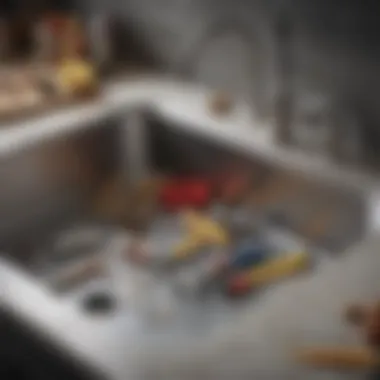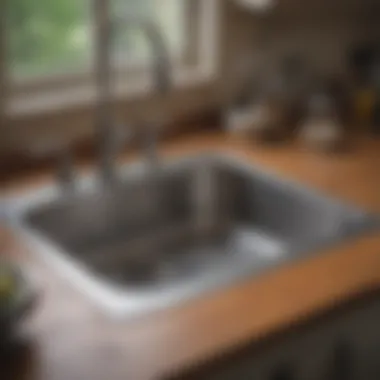Practical Strategies for Unclogging Your Kitchen Sink


Intro
Keeping a sink flowing freely is not just about convenience; it is also about maintaining hygiene and preventing water damage in the kitchen. By the end of this guide, it will be clearer how strategic methods can resolve clogs and ensure long-term effectiveness.
Understanding Kitchen Sink Clogs
Clogs often develop from a combination of factors. Food waste, grease, and foreign objects can accumulate over time, leading to blockage. Additionally, some sinks may have aging plumbing that exacerbates drainage issues. Understanding these causes allows homeowners to choose the appropriate cleaning method.
Important points to note:
- Food waste: Residue from cooking and dishwashing can build up in drains.
- Grease: Pouring fats down the sink solidifies as it cools, creating blockages.
- Foreign objects: Items like utensils or packaging may accidentally fall into the sink.
Knowing these elements helps in selecting the most effective cleaning technique.
DIY Cleaning Techniques
For many homeowners, DIY solutions are appealing. They often require minimal equipment and can be quickly executed. Here are some reliable methods:
- Boiling Water: A simple yet effective method is to pour boiling water down the drain. This can help melt away grease and organic materials.
- Baking Soda and Vinegar: Combining these two ingredients can create a natural foaming reaction. Pour half a cup of baking soda followed by around half a cup of vinegar into the drain. Let it sit for about 30 minutes, then flush with hot water.
- Plunger: Using a plunger can be useful for stubborn clogs. Ensure that there is enough water in the sink to cover the plunger's cup. Plunge vigorously a few times.
- Wet/Dry Vacuum: If you have a wet/dry vacuum, set it to liquid mode. Place the nozzle over the drain and create a tight seal. This can help suck out the clog, particularly if it’s near the surface.
Each of these methods can be effective based on the cause of the clog.
When to Seek Professional Help
Sometimes, home methods do not yield results. In such cases, hiring a professional plumber may be necessary. Licensed plumbers have tools and expertise that exceed typical household capabilities. They can diagnose deeper issues like tree root intrusion or damaged pipes that might cause repeated clogs.
Homeowners should consider a professional service if:
- Multiple clogs occur frequently.
- There is gurgling or unusual noises from the sink.
- A foul odor persists despite attempts to clean.
"A thorough diagnosis by professionals may prevent more serious plumbing issues later on."
Preventive Measures
To prevent future clogs, adopting good habits is essential. Here are some tips:
- Dispose of grease properly: Instead of pouring fats down the drain, allow them to solidify and dispose of them in the trash.
- Use a drain strainer: This can catch food particles and prevent them from entering the plumbing.
- Flush drains regularly: Periodically pouring boiling water or vinegar can help keep the pipes clear.
By following these preventive measures, homeowners can minimize the chances of encountering a clogged kitchen sink in the future.
The End
Dealing with a clogged kitchen sink does not have to be overwhelming. Equipped with both DIY techniques and knowledge about when to call professionals, homeowners can protect their kitchen's functionality. A better understanding of clog causes, alongside effective cleaning methods, aids in maintaining a hassle-free and efficient kitchen space.
Understanding the Common Causes of Clogs
Understanding why kitchen sinks clog is crucial for effective maintenance and cleaning. Knowing the common causes can help homeowners address issues before they escalate. The following sections discuss the most frequent culprits behind clogs and how to manage them.
Food Residue and Grease Buildup
Food particles and grease often form a significant barrier within kitchen drains. When food waste goes down the sink, it might seem harmless at first. However, over time, these remnants can accumulate, creating a thick layer inside the pipes. Grease, in particular, tends to solidify as it cools, leading to stubborn blockages.


To mitigate this issue, it is advisable to scrape plates into the trash before rinsing. Keeping un-oily wastes away from the drain is vital. In addition, using a strainer prevents smaller particles from entering the pipe.
Foreign Objects and Blockages
Sometimes, clogs are not a result of food at all, but rather foreign objects accidentally entering the drain. Items such as utensils, small toys, or even pieces of packaging can create serious blockages. These objects can get lodged in pipes, causing water to back up and create further issues.
To reduce the risk of these blockages, educate household members about what should and should not be disposed of down the sink. Additionally, regular checkups on sink areas can help catch potential threats before they enter the drainage system.
Pipe and Drainage Issues
Different kinds of pipe problems can also contribute to a clogged kitchen sink. Issues like cracks, misalignments, or deterioration from age can lead to blockages. When pipes are compromised, waste cannot flow freely, and this creates an environment ripe for clogs.
Regular inspections can identify potential drainage issues before they become significant problems. If any unusual sounds or slow drainage is noted, it may be time for a deeper look into the plumbing system.
Initial Assessment of the Clog
Assessing a clog in your kitchen sink is a crucial first step towards an effective and efficient resolution. Understanding the nature of the blockage can save time and prevent the use of unnecessary tools or chemicals. This assessment involves both visual inspection and testing of drainage, giving you insights into the potential causes and severity of the clog.
- Benefits of Initial Assessment
- Considerations: Be thorough in your assessment, as ignoring the details can lead to recurring issues. Take notes if necessary, and be prepared to adapt your approach based on what you find.
- Saves Time: Knowing the cause allows for more targeted interventions.
- Reduces Damage: Prevents further complications in the plumbing system.
- Informs Methods: Different clog types may require different strategies.
Visual Inspection Techniques
The first step involves a visual inspection of your plumbing area. Look for signs of overflowing or pooling water, which may indicate where the blockage is occurring. Utilize a flashlight to illuminate darker areas under the sink.
- Check for Leaks: Examine pipes for any visible leaks or wetness that may hint at a more serious issue.
- Observe the Drain Opening: Ensure that there are no visible obstructions like food particles or foreign objects that could be blocking the path.
- Follow the Plumbing Lines: Inspect the visible sections of plumbing for any potential problems, such as corrosion or cracks.
Testing Water Flow and Drainage
After the visual inspection, it's essential to test the water flow. This will give a clearer picture of the problem.
- Run the Tap: Open the faucet and note how water flows. Slow drainage indicates a blockage somewhere in the system.
- Observe Gurgling Sounds: Listen for gurgling noises, as they can signal air trapped in the pipes due to a clog.
- Check Other Sinks: If you have multiple sinks in your home, see if they are experiencing similar drainage issues; this may point to a wider block in the system.
"A clear assessment can lead to a more effective treatment method, avoiding the pitfalls of guesswork."
Understanding the problem allows the homeowner to proceed with confidence toward finding a solution, whether through DIY methods or calling for professional help.
DIY Solutions for Sink Clogs
In the pursuit of resolving clogged kitchen sinks, DIY solutions hold significant value. They not only provide cost-effective alternatives to professional assistance but also empower homeowners with the tools and knowledge to manage their plumbing issues independently. Understanding these methods can save time and resources, allowing for immediate action without the need to wait for a plumber to arrive. The gratification derived from successfully unclogging a sink reinforces the importance of self-reliance and basic plumbing knowledge.
Boiling Water Method
The boiling water method is one of the simplest yet effective techniques available for unclogging kitchen sinks. By pouring boiling water directly down the drain, it can effectively dissolve minor clogs caused by food residue, grease, or soap buildup. This method is particularly beneficial because it requires minimal effort and no specialized tools. However, one must exercise caution to avoid damaging plastic pipes. For best results, this method should be repeated several times.
Baking Soda and Vinegar Approach
Utilizing baking soda and vinegar is a highly regarded DIY approach for sink clogs. First, pour a cup of baking soda down the drain, followed by a cup of vinegar. The reaction between these two ingredients creates fizzing action that can break down stubborn clogs. Allow the mixture to sit for at least 30 minutes before flushing it down with hot water. This technique is not only effective but also environmentally friendly, avoiding harmful chemicals that might damage pipes in the long run.
Manual Clearing Techniques


Plumber's Snake
The plumber's snake is a valuable tool in the arsenal for dealing with sink clogs. It consists of a long, flexible metal wire designed to navigate the twists and turns of plumbing pipes. The unique characteristic of a plumber's snake is its ability to reach deep into the drain's system, effectively dislodging tougher blockages that other methods might miss. This tool is popular due to its effectiveness in situations where simple methods fail. However, it requires some skill to use properly, and there's a risk of damaging pipes if not handled carefully.
Plunger Use
The plunger is another essential tool for tackling sink clogs. It works by creating suction that can help dislodge obstructions within the pipes. The main feature of a plunger is its simple design, making it accessible for everyone. Its widespread use stems from its efficiency in various scenarios, not just in kitchen sinks but also in toilets and bathtubs. While plunging is generally beneficial, its effectiveness may be limited for severe clogs or in cases where the obstruction is deep within the plumbing system.
Wet/Dry Vacuum Utilization
Employing a wet/dry vacuum can be a highly effective solution for severe kitchen sink clogs. This powerful tool can suction out both liquids and solids from the drain, providing a thorough cleaning that many DIY methods cannot achieve. To utilize this method, ensure that the vacuum is set to liquid mode. Insert the hose into the drain and create a tight seal to optimize suction. However, it is crucial to note the potential for mess and the need for specific equipment.
Engaging in these DIY methods equips homeowners with the ability to maintain their kitchen sinks efficiently. Each method offers distinct benefits and can be chosen based on the particular situation encountered. Proper knowledge and understanding of these approaches lead to more effective problem resolutions.
Chemical Solutions and Considerations
In the context of resolving clogged kitchen sinks, chemical solutions represent a significant avenue worth exploring. These solutions consist of various substances that can effectively break down clogs, providing a more direct method than traditional mechanical approaches. The use of chemical drain cleaners offers several benefits. They can often resolve blockages quickly, making them an appealing option for those eager to restore functionality to their sinks without much delay. However, some critical considerations accompany the use of chemicals.
First, the nature of the clogs must be assessed. Chemical cleaners typically excel at dissolving organic material and grease, while foreign objects or solid blockages may require different interventions. The effectiveness of these products can vary based on the specific type of clog, so understanding this relationship can help guide the decision on whether to use a chemical cleaner.
Moreover, the potential for damage to plumbing infrastructure due to the harshness of some chemicals cannot be overlooked. Homeowners should scrutinize product labels for safety and compatibility with pipes. Overuse or misuse of such chemicals can lead to corrosive damage, necessitating costly repairs down the line.
Another consideration is the environmental impact. Many commercial cleaners contain toxins that can harm aquatic life and disrupt ecosystems if they enter sewer systems. Thus, selecting biodegradable or environmentally-friendly options is prudent for those conscious of their ecological footprint. Ultimately, while chemical solutions can be effective, they should be approached with caution.
Common Chemical Drain Cleaners
A variety of chemical drain cleaners are available on the market. Each with distinct formulations and intended uses. Here are some common options:
- Sodium hydroxide: Often found in heavy-duty cleaners, it works to dissolve grease and organic material by chemical reaction.
- Sulfuric acid: This cleaner is potent and can effectively dissolve even the toughest clogs. However, it requires extreme caution due to its corrosive nature.
- Enzyme-based cleaners: These are designed to break down organic matter using biological enzymes. They are typically less harmful to pipes but may take longer to show results.
- Bleach: While not a conventional drain cleaner, it can help disinfect areas post-cleanup but is not advisable for continuous use due to potential pipe damage.
Understanding these common chemical solutons allows homeowners to choose the right product for their needs. It is important to follow the manufacturer’s instructions to ensure safe and effective cleaning.
Safety Measures and Precautions
Using chemical solutions demands serious attention to safety protocols. Here are key safety measures:
- Read labels carefully: Always read and understand instructions before use.
- Use protective gear: Gloves, goggles, and, when necessary, masks are essential to shield from harmful fumes and splashes.
- Proper ventilation: Ensure adequate airflow in the area during application to reduce inhalation risks from fumes.
- Avoid mixing chemicals: Combining various cleaners can produce dangerous reactions. Stick to one product at a time.
- Store safely: Keep chemical cleaners out of reach of children and pets to prevent accidental ingestion.
"Preventive measures are often more effective than reactive measures in dealing with clogs."
In summary, while chemical solutions provide a viable option for clearing clogs, homeowners must weigh the benefits against the risks. Taking the necessary safety precautions is critical to ensure a successful and safe cleaning process.
Preventative Methods to Avoid Future Clogs
Avoiding future clogs in the kitchen sink can save homeowners a significant amount of time, effort, and money. The reality is that many clogs originate from simple habits that can be modified or eliminated entirely. By fostering a proactive approach to kitchen sink maintenance, the likelihood of severe clogs forming decreases drastically. Not only does this preserve the functionality of kitchen plumbing, but it also enhances longevity, thus reducing the need for future repairs or interventions.
Regular Maintenance Practices
Engaging in regular maintenance plays a critical role in ensuring that your kitchen sink remains unclogged. This involves simple, routine actions that can prevent accumulation of debris and sediments. Here are some effective practices:
- Routine Cleaning: Frequent cleaning of the sink and surrounding area can help in spotting issues early. Use a mixture of vinegar and baking soda regularly; this is effective in breaking down grease buildup.
- Sieve or Strainer Usage: Installing a sink strainer can prevent food particles from entering the drain. Empty it often to maximize its effectiveness.
- Hot Water Flush: Periodically pouring boiling water down the drain helps dissolve accumulated grease. This can be especially beneficial after cooking meals that involve oils or fats.


If these simple maintenance tasks are performed regularly, the need for drastic measures when dealing with clogs can be greatly minimized.
Proper Disposal and Usage Guidelines
Understanding what can and cannot be disposed of down the kitchen sink is paramount in preventing clogs. Compliance with proper disposal guidelines significantly reduces the risk of foreign objects causing blockages. Consider the following points:
- Avoid Grease and Fat: Do not pour any kind of grease, oil, or vegetable fat down the sink. They can solidify and cause blockages in the pipes.
- Food Waste Disposal: Utilize a composting system for scraps like vegetables instead of grinding them down your disposal unit. Even in moderation, fibrous or starchy items can lead to clogs.
- Safe Use of Garbage Disposal: When using a garbage disposal, run water for a few minutes after to flush down any remaining particles. Always ensure the disposal is turned on before adding food waste to avoid choking the unit.
Implementing these practices is key in maintaining a smooth-running kitchen sink.
Being conscious about your sink usage and taking preventive actions can lead to fewer service calls and a more efficient kitchen. The benefits of regular maintenance and proper disposal cannot be overstated; they are central to keeping your kitchen sink functioning seamlessly.
When to Call a Professional Plumber
Clogged kitchen sinks can often frustrate homeowners. However, there comes a point when DIY solutions are not sufficient. Knowing when to call a professional plumber is critical to avoid further damage or compounding the issue. Here are the key elements to consider.
Identifying Severe Clogs
Severe clogs are typically characterized by persistent blockage even after multiple attempts at DIY clearing solutions. If you have tried methods such as boiling water, baking soda with vinegar, or even a plunger, and the issue remains unresolved, it might be time to call for professional help.
Other signs indicating severe clogs include:
- Backflow: Water or waste starting to back up into the sink after attempts to drain.
- Multiple drainage issues: Other sinks, toilets, or bathroom fixtures showing slow drainage simultaneously.
- Foul odors: Unpleasant smells originating from the sink or drain, which could indicate a more serious problem.
- Water pooling: Significant water accumulation in the sink or the surrounding area may signal a serious blockage in the drainage pipe.
If you experience any of these symptoms, hiring a plumber can save time and prevent worsening the situation.
Estimating Costs of Professional Services
Understanding the potential costs involved with hiring a plumber can help you budget accordingly. The cost for professional plumbing services can vary widely. Factors influencing pricing include:
- Location: Rates can differ based on geographical location, with urban areas generally having higher charges.
- Severity of problem: Complex issues that require extensive work will increase the total expense.
- Time of call: Emergency calls and service during off-hours typically come with a premium.
Typical costs for plumbing services range from $100 to $300 for standard unclogging jobs. However, significant issues might escalate this price considerably. It’s wise to obtain estimates from several professionals and verify their credentials beforehand.
Remember, attempting to fix a severe clog without adequate skill or tools can lead to costly repairs down the line. It's often better to invest in a qualified plumber for complex situations.
Ending and Key Takeaways
First, one must recognize the common causes of clogs, such as food residue, grease buildup, and foreign objects. This awareness enables homeowners to take proactive measures. Employing do-it-yourself solutions, like boiling water and a vinegar and baking soda mix, often provides immediate results. Alternatively, using mechanical tools such as a plumber’s snake or plunger can resolve more stubborn clogs.
Considerations regarding chemical drain cleaners are also worth noting. While they can be effective, safety measures are paramount due to the potential hazards associated with these products. It's advisable to weigh their pros and cons before use, and follow instructions carefully.
Finally, maintaining a clean kitchen sink requires routine maintenance and mindful disposal practices. Regular checks and preventive measures can significantly reduce the likelihood of clogs in the future. By investing time in these areas, one can ensure a smooth-running kitchen sink.
"An ounce of prevention is worth a pound of cure." This sentiment rings profoundly true when it comes to maintaining plumbing systems in a home.
With these strategies, homeowners can confidently tackle sink clogs and uphold the efficiency of their kitchens.
Summary of Effective Strategies
- Identify Common Causes: Understand factors like food residue, grease, and foreign objects that contribute to clogs.
- DIY Solutions: Utilize methods such as boiling water, baking soda, and vinegar, along with manual tools like a plunger or plumber’s snake to clear obstructions.
- Chemical Cleaners: Use chemical drain cleaners cautiously, following safety protocols and considering alternative methods when available.
- Routine Maintenance: Regularly inspect and clean the sink to prevent buildup and future clogs.
Long-Term Maintenance Recommendations
To ensure the longevity of your kitchen sink and plumbing system, it is crucial to adopt long-term maintenance practices. Here are several recommendations:
- Routine Cleaning: Clean the sink regularly with warm, soapy water to avoid residue buildup.
- Mindful Disposal: Dispose of grease, food particles, and other clog-inducing materials properly in the trash rather than down the drain.
- Use Drain Screens: Install screens or strainers to catch debris before it enters the drain.
- Periodic Professional Check-ups: Consider having a plumber inspect your plumbing systems periodically to catch issues before they escalate.
By adhering to these practices, individuals can maintain a well-functioning kitchen sink, thereby enhancing their overall kitchen experience.







